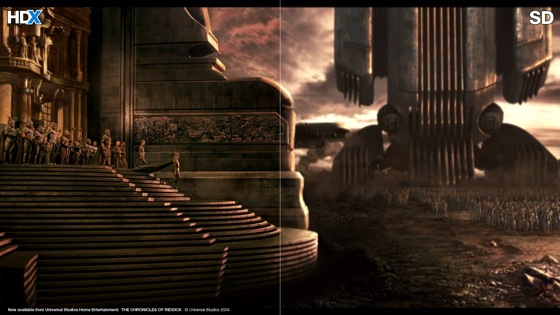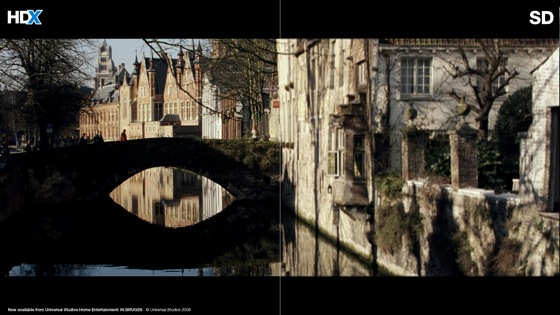 Well, look at that. We caught wind of HDX last month and today Vudu made their full high definition content service official. HDX is aimed directly at HD aficionados with 1080p screens larger than 42-inches. Pricing for HDX content won’t cost you anymore than the HD content they currently offer. A total of 65 HDX titles rolled out tonight, which include The Spiderwick Chronicles, In Bruges, Speed Racer and Classics such as Close Encounters of the Third Kind, Chinatown, and Saturday Night Fever with more to follow as new titles are being brought to market. Vudu will begin converting existing titles in their catalog to the HDX format.
Well, look at that. We caught wind of HDX last month and today Vudu made their full high definition content service official. HDX is aimed directly at HD aficionados with 1080p screens larger than 42-inches. Pricing for HDX content won’t cost you anymore than the HD content they currently offer. A total of 65 HDX titles rolled out tonight, which include The Spiderwick Chronicles, In Bruges, Speed Racer and Classics such as Close Encounters of the Third Kind, Chinatown, and Saturday Night Fever with more to follow as new titles are being brought to market. Vudu will begin converting existing titles in their catalog to the HDX format.
Best Buy now carries Vudu and is offering new customers a $200 credit for a limited time.
How good is it? Hit the jump for comparisons and to learn about Vudu’s TruFilm Technology.
TruFilm is made up of the following components.
PSYCHOVISUAL PROCESSING
The human eye is not uniformly sensitive to detail in light and dark areas of an image. With careful use of this knowledge during encoding, it is possible to exploit this sensitivity difference to improve the compression of the video and the perceived detail. The simplest forms of this have been in place for many years in digital video. For example, chroma subsampling reduces the amount of bandwidth allocated to the color channels, since the human eye is much more sensitive to luminance (brightness) than it is to chrominance (color).VUDU’s encoder uses more advanced algorithms than used in the past by taking into consideration changes in brightness. The eye is much more sensitive to high frequency (fine texture) detail in bright areas. As a result it is possible to reallocate bits from lower-complexity parts of the image in order to noticeably boost quality. Other encoders have the tendency to overly reallocate from large flat areas which can introduce blocking artifacts to the image. The Adaptive Quantization functionality in VUDU’s encoder considers scenarios such as these and more intelligently allocates data within the frame. As a result, VUDU is able to improve overall image quality with enhanced details in dark areas of the picture while virtually removing the artifacts typically present and often noticed in other Internet-delivered or broadcast video.
FILM GRAIN PRESERVATION
As an analog medium, film inherits a large part of its look and feel from the chemistry of the film itself. This is most visible to the viewer as film grain. The amount and look of the grain is the result of the film stock and the exposure settings used by the filmmaker. Directors and photographers go to great lengths in selecting the appropriate film and settings to give their movies the look and feel that they want to communicate. Modern digital video encoding techniques often remove much the film grain either intentionally (because it looks similar to noise in the image) or through accident (because the encoder over-compresses the video and loses detail, including the grain). . This
results in an encoded picture that not only fails to preserve the vision of the filmmaker but also displays visible artifacts in grainy underexposed areas of the picture. VUDU’s Film Grain Preservation technology detects this film grain prior to encoding and ensures that the film grain is preserved and present on the video for display to the viewer.STATISTICAL VARIABLE BIT RATE
As discussed above, while VBR encoding offers potentially better quality, it is difficult to stream as compared to CBR encodings. This can lead to a choice between downloading a high-quality video for delayed, offline viewing and streaming a lower-quality video for instant gratification. VUDU employs a carefully-controlled application of HDX by VUDU 9 VBR encoding called Statistical Variable Bit Rate that optimizes the beginning of the movie for quick streaming access and then enforces a peak bit rate limit on the rest of the movie to aid in predictability. Additionally, VUDU’s encoder performs multiple encoding passes over the video to help make intelligent rate control decisions, while
maintaining a “variable bit rate buffer”, which essentially allows for variability in bit rate without breaking the average and maximum bit rate constraints. All of this helps preserve the quality of the film while providing the predictability required, allowing instant viewing of the movie over the Internet.COLOR GRADIENT PROCESSING
Many video compression systems create pictures that are optimized for CRT displays, rather than modern LCD and Plasma digital displays. The display characteristics of the latter displays are different from that of the CRT, and can expose artifacts that may remain well-hidden in CRTs. A common example of such artifacts is visible in images with subtle color gradients, such as an expanse of blue depicting a cloudless sky. In such images, one can often see banding or “false contouring” on an LCD or Plasma display while a CRT might be more forgiving. VUDU designed its hardware and encoding software with these display technologies in mind. Through a technique
known as Color Gradient Processing VUDU identifies potential trouble areas present in an image and tunes the image for the best result possible with LCD and Plasma flat panel displays.
Those long download times are true, but Vudu is hoping you’ll queue HDX movies online or hours before you’re ready to watch. I’m down with picking out movies online while I’m at work, so they’re ready to go when I get home.

